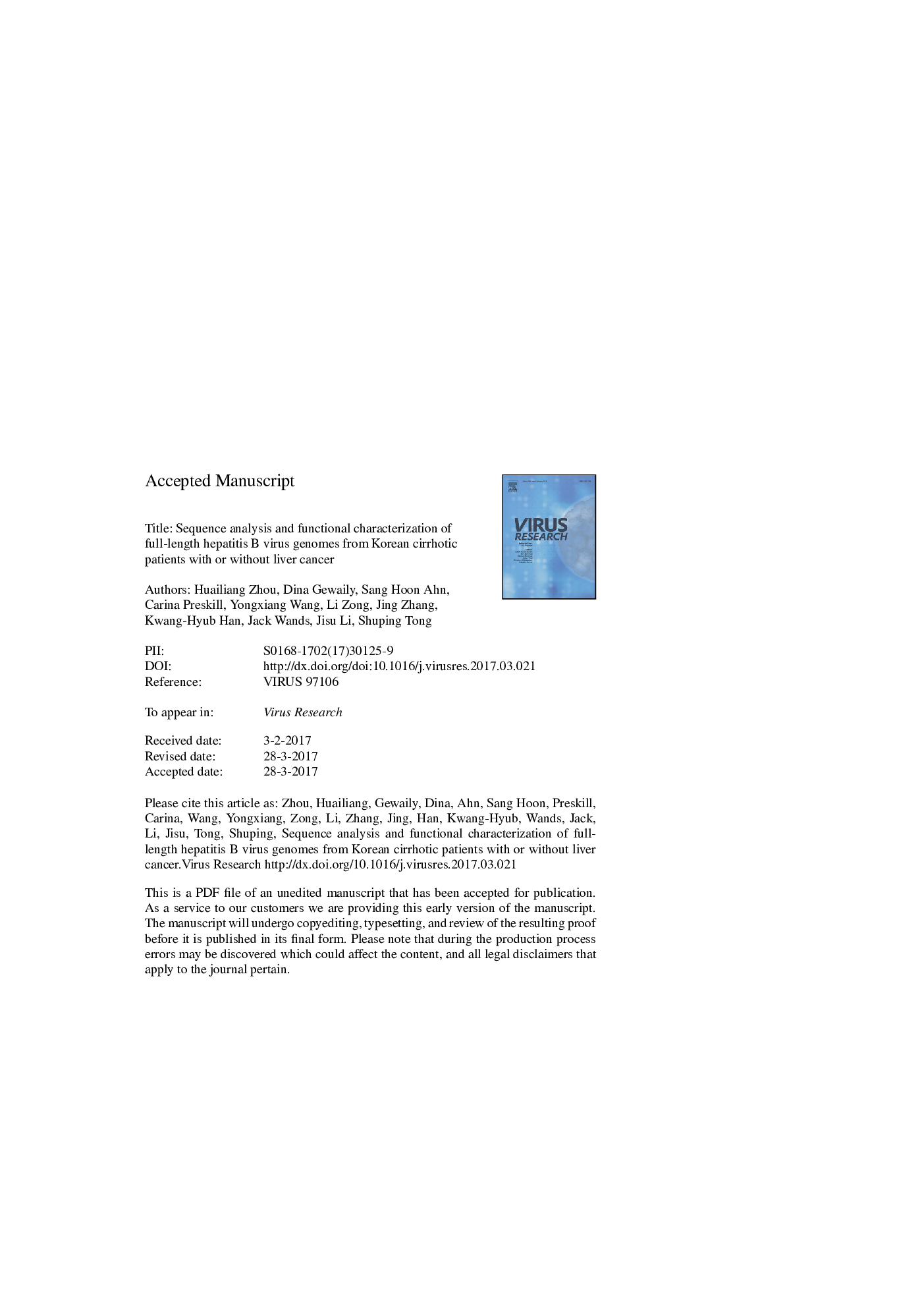| کد مقاله | کد نشریه | سال انتشار | مقاله انگلیسی | نسخه تمام متن |
|---|---|---|---|---|
| 5675328 | 1594322 | 2017 | 39 صفحه PDF | دانلود رایگان |
عنوان انگلیسی مقاله ISI
Sequence analysis and functional characterization of full-length hepatitis B virus genomes from Korean cirrhotic patients with or without liver cancer
دانلود مقاله + سفارش ترجمه
دانلود مقاله ISI انگلیسی
رایگان برای ایرانیان
کلمات کلیدی
pgRNAHBsAgHBeAgHCC - HCCpregenomic RNA - RNA pregenomicHepatitis B surface antigen - آنتی ژن سطحی هپاتیت Bsupernatant - ابرنواخترELISA - تست الیزاEnzyme-linked immunosorbent assay - تست الیزاGenome replication - تکثیر ژنومprecore - دقتLiver cancer - سرطان کبدSup - سوپwild type - نوع وحشیHepatitis B e antigen - هپاتیت B آنتی ژنHBV - هپاتیت بpolymerase chain reaction - واکنش زنجیره ای پلیمرازPCR - واکنش زنجیرهٔ پلیمرازhepatitis B virus - ویروس هپاتیت بیcore promoter - پروژکتور هسته ایpolyethylene glycol - پلی اتیلن گلیکولPolymerase - پلیمرازPEG - پلیاتیلن گلیکول Hepatocellular carcinoma - کارسینوم هپاتوسلولار(کارسینوم سلولهای استخوانی)
موضوعات مرتبط
علوم زیستی و بیوفناوری
ایمنی شناسی و میکروب شناسی
ویروس شناسی
پیش نمایش صفحه اول مقاله

چکیده انگلیسی
This study aimed to identify and characterize mutations in the hepatitis B virus (HBV) genome associated with advanced liver diseases. The 3.2-kb HBV genome of the C2 subgenotype was amplified from sera of 18 cirrhotic Korean patients with (10) or without (8) hepatocellular carcinoma (HCC), and two clones per patient were characterized by transient transfection experiments in human hepatoma cells. While A1762T/G1764A core promoter mutations were highly prevalent in both groups, the G1896A precore mutation to abolish hepatitis B e antigen (HBeAg) expression was more common in HCC clones (55% vs. 20%). High replication capacity was mostly found in HCC clones and associated with core promoter mutations, whereas more non-HCC clones harbored a nonfunctional core gene (34% vs. 8%). Large in-frame deletions in the preS region were found in 60% of HCC clones and 38% of non-HCC clones. They removed the first 11 residues of large envelope protein or impaired small envelope protein expression, or deleted a neutralizing epitope in the preS2 domain. Additional point mutations prevented middle envelope protein expression, or caused nonsense mutations in the preS or S region to truncate large and/or small envelope protein. Consequently, many clones were unable to express or secrete hepatitis B surface antigen (HBsAg). In conclusion, mutations associated with the advanced stage of chronic HBV infection are complex and diverse. Host immune pressure most likely selected for mutations in the HBV genome to abolish or reduce HBeAg or HBsAg production, to enhance genome replication, or to escape neutralizing antibodies. Some of these mutations may contribute to liver cirrhosis or HCC development.
ناشر
Database: Elsevier - ScienceDirect (ساینس دایرکت)
Journal: Virus Research - Volume 235, 2 May 2017, Pages 86-95
Journal: Virus Research - Volume 235, 2 May 2017, Pages 86-95
نویسندگان
Huailiang Zhou, Dina Gewaily, Sang Hoon Ahn, Carina Preskill, Yongxiang Wang, Li Zong, Jing Zhang, Kwang-Hyub Han, Jack Wands, Jisu Li, Shuping Tong,